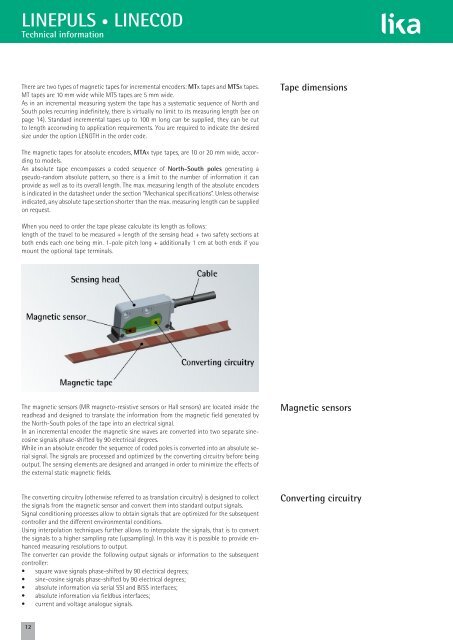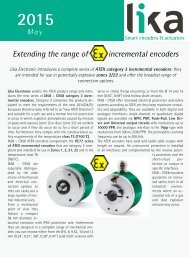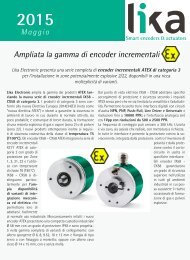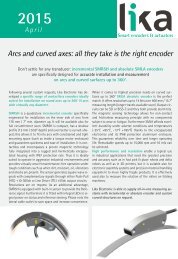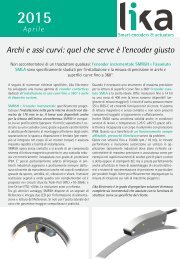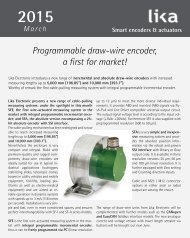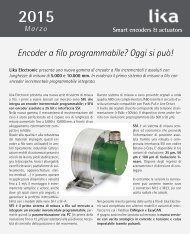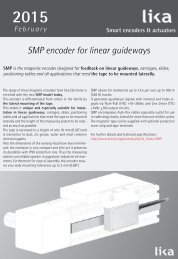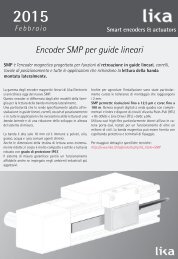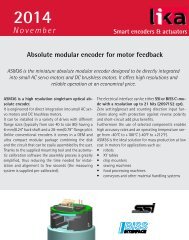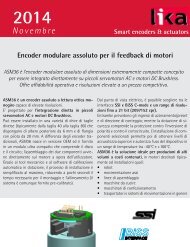LINEPULS & LINECOD catalogue 2016 in English
Lika Electronic incremental and absolute linear encoders catalogue 2016 in English Our new linear encoders catalogue is out now, and features many innovative new products and up-to-date information. The catalogue is expressly designed to set out the comprehensive range of incremental & absolute linear encoders from Lika Electronic. Check it out, it is completely renewed! Make sure you don’t miss out on a copy, download the pdf file from our web site or request your hard copy now! We have also got an interactive digital version in the works that shall be released soon!
Lika Electronic incremental and absolute linear encoders catalogue 2016 in English
Our new linear encoders catalogue is out now, and features many innovative new products and up-to-date information. The catalogue is expressly designed to set out the comprehensive range of incremental & absolute linear encoders from Lika Electronic. Check it out, it is completely renewed!
Make sure you don’t miss out on a copy, download the pdf file from our web site or request your hard copy now!
We have also got an interactive digital version in the works that shall be released soon!
You also want an ePaper? Increase the reach of your titles
YUMPU automatically turns print PDFs into web optimized ePapers that Google loves.
<strong>LINEPULS</strong> • <strong>LINECOD</strong><br />
Technical <strong>in</strong>formation<br />
There are two types of magnetic tapes for <strong>in</strong>cremental encoders: MTx tapes and MTSx tapes.<br />
MT tapes are 10 mm wide while MTS tapes are 5 mm wide.<br />
As <strong>in</strong> an <strong>in</strong>cremental measur<strong>in</strong>g system the tape has a systematic sequence of North and<br />
South poles recurr<strong>in</strong>g <strong>in</strong>def<strong>in</strong>itely, there is virtually no limit to its measur<strong>in</strong>g length (see on<br />
page 14). Standard <strong>in</strong>cremental tapes up to 100 m long can be supplied, they can be cut<br />
to length accorwd<strong>in</strong>g to application requirements. You are required to <strong>in</strong>dicate the desired<br />
size under the option LENGTH <strong>in</strong> the order code.<br />
Tape dimensions<br />
The magnetic tapes for absolute encoders, MTAx type tapes, are 10 or 20 mm wide, accord<strong>in</strong>g<br />
to models.<br />
An absolute tape encompasses a coded sequence of North-South poles generat<strong>in</strong>g a<br />
pseudo-random absolute pattern, so there is a limit to the number of <strong>in</strong>formation it can<br />
provide as well as to its overall length. The max. measur<strong>in</strong>g length of the absolute encoders<br />
is <strong>in</strong>dicated <strong>in</strong> the datasheet under the section “Mechanical specifications”. Unless otherwise<br />
<strong>in</strong>dicated, any absolute tape section shorter than the max. measur<strong>in</strong>g length can be supplied<br />
on request.<br />
When you need to order the tape please calculate its length as follows:<br />
length of the travel to be measured + length of the sens<strong>in</strong>g head + two safety sections at<br />
both ends each one be<strong>in</strong>g m<strong>in</strong>. 1-pole pitch long + additionally 1 cm at both ends if you<br />
mount the optional tape term<strong>in</strong>als.<br />
The magnetic sensors (MR magneto-resistive sensors or Hall sensors) are located <strong>in</strong>side the<br />
readhead and designed to translate the <strong>in</strong>formation from the magnetic field generated by<br />
the North-South poles of the tape <strong>in</strong>to an electrical signal.<br />
In an <strong>in</strong>cremental encoder the magnetic s<strong>in</strong>e waves are converted <strong>in</strong>to two separate s<strong>in</strong>ecos<strong>in</strong>e<br />
signals phase-shifted by 90 electrical degrees.<br />
While <strong>in</strong> an absolute encoder the sequence of coded poles is converted <strong>in</strong>to an absolute serial<br />
signal. The signals are processed and optimized by the convert<strong>in</strong>g circuitry before be<strong>in</strong>g<br />
output. The sens<strong>in</strong>g elements are designed and arranged <strong>in</strong> order to m<strong>in</strong>imize the effects of<br />
the external static magnetic fields.<br />
The convert<strong>in</strong>g circuitry (otherwise referred to as translation circuitry) is designed to collect<br />
the signals from the magnetic sensor and convert them <strong>in</strong>to standard output signals.<br />
Signal condition<strong>in</strong>g processes allow to obta<strong>in</strong> signals that are optimized for the subsequent<br />
controller and the different environmental conditions.<br />
Us<strong>in</strong>g <strong>in</strong>terpolation techniques further allows to <strong>in</strong>terpolate the signals, that is to convert<br />
the signals to a higher sampl<strong>in</strong>g rate (upsampl<strong>in</strong>g). In this way it is possible to provide enhanced<br />
measur<strong>in</strong>g resolutions to output.<br />
The converter can provide the follow<strong>in</strong>g output signals or <strong>in</strong>formation to the subsequent<br />
controller:<br />
• square wave signals phase-shifted by 90 electrical degrees;<br />
• s<strong>in</strong>e-cos<strong>in</strong>e signals phase-shifted by 90 electrical degrees;<br />
• absolute <strong>in</strong>formation via serial SSI and BiSS <strong>in</strong>terfaces;<br />
• absolute <strong>in</strong>formation via fieldbus <strong>in</strong>terfaces;<br />
• current and voltage analogue signals.<br />
Magnetic sensors<br />
Convert<strong>in</strong>g circuitry<br />
12


